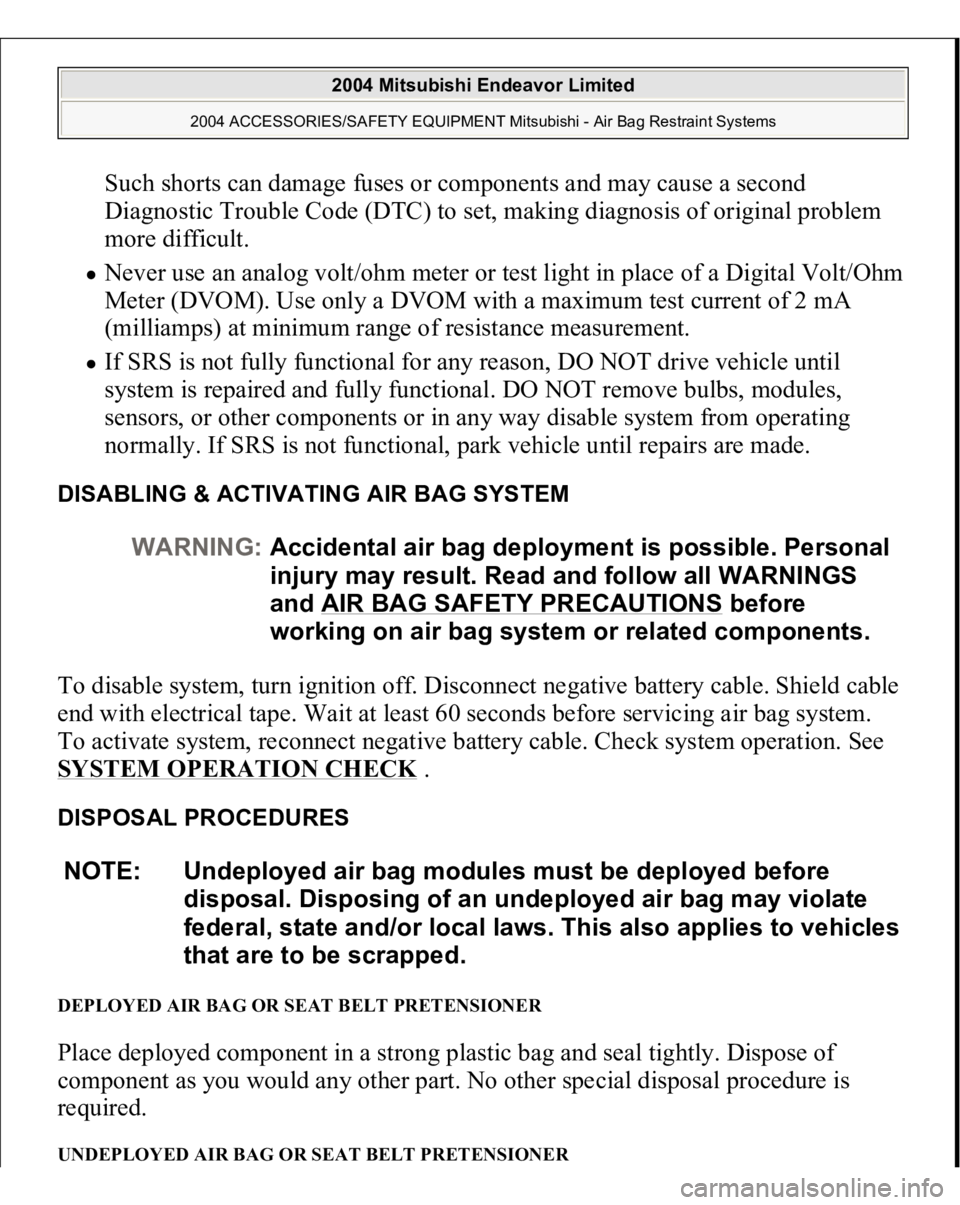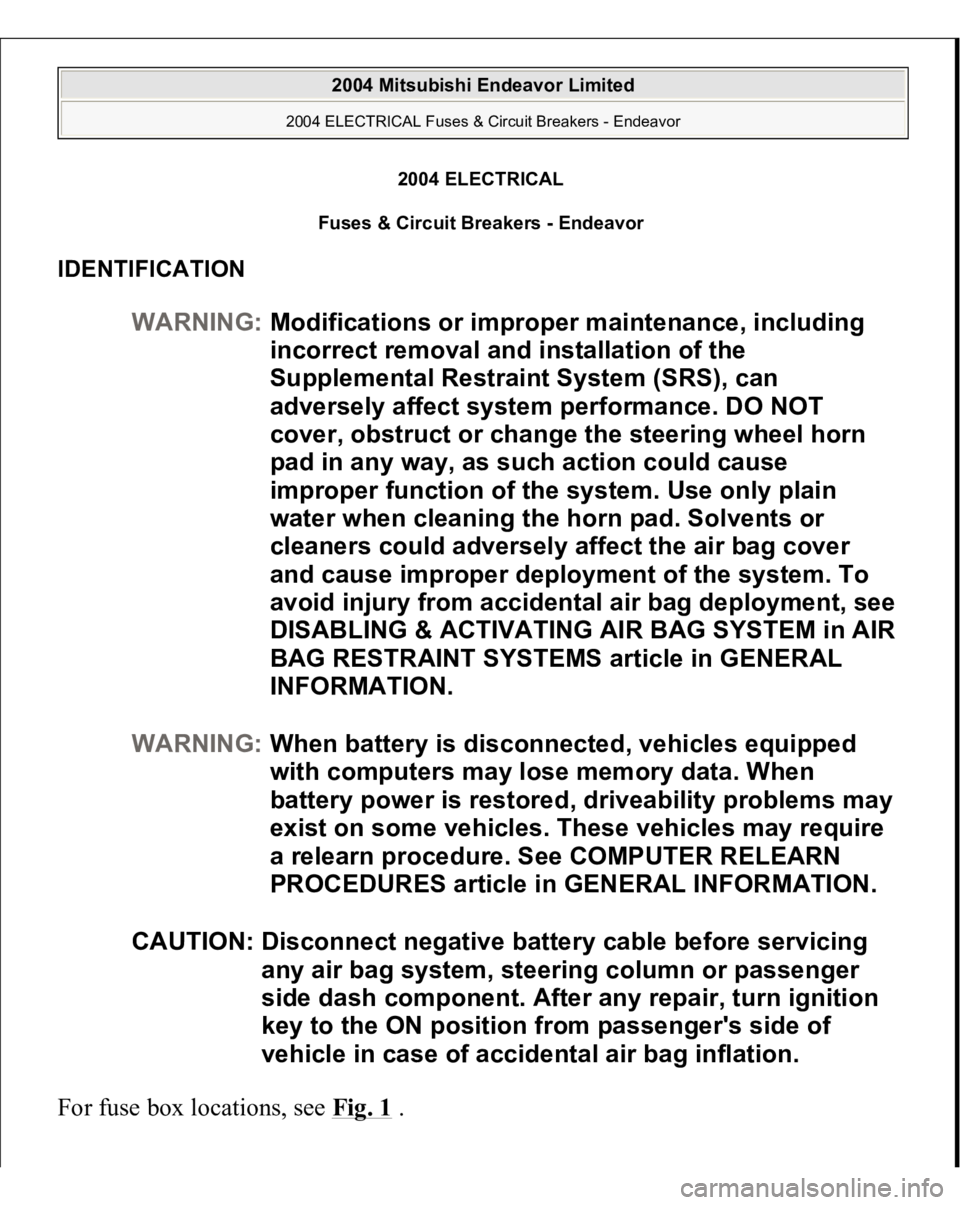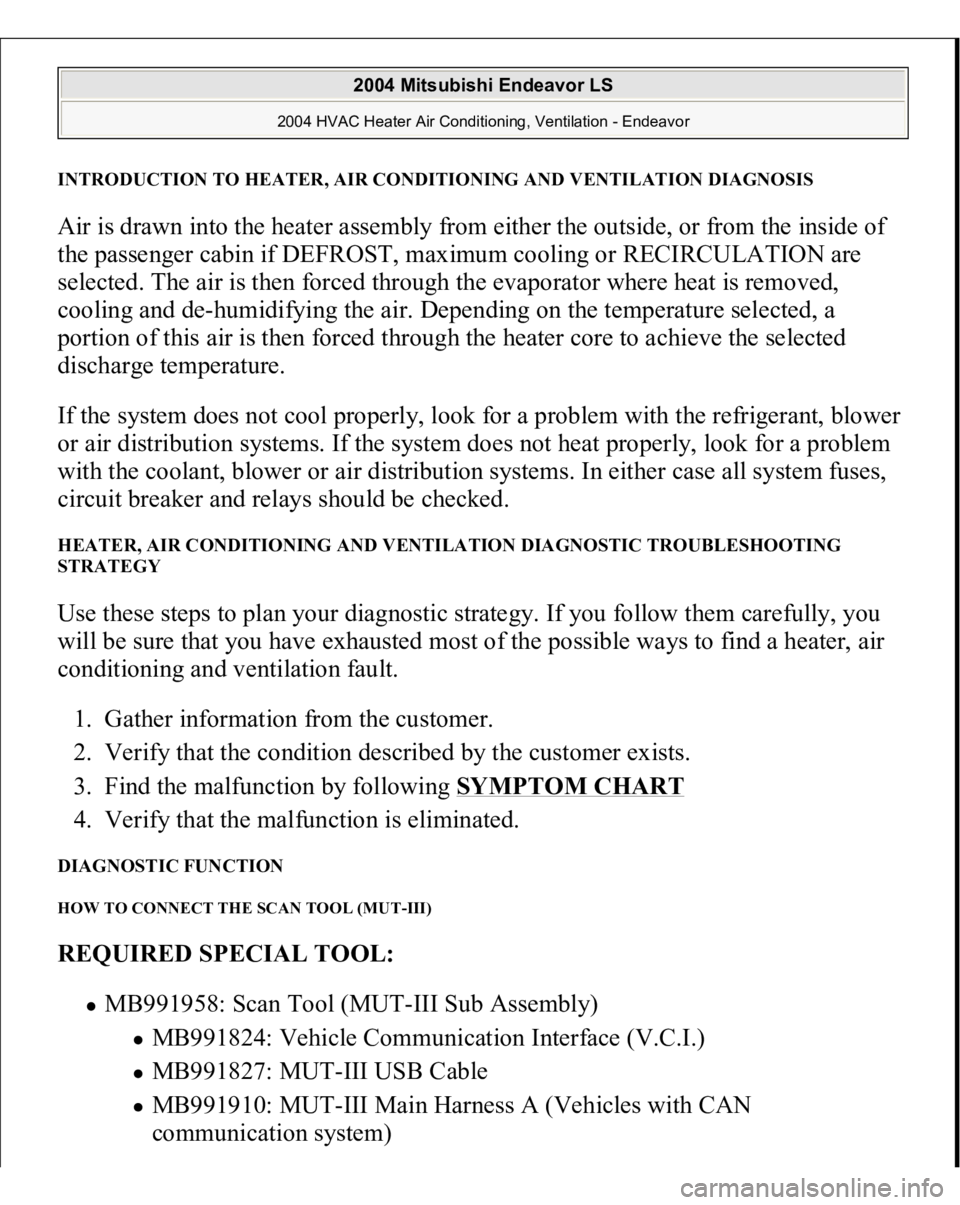Page 277 of 3870

Such shorts can damage fuses or components and may cause a second
Diagnostic Trouble Code (DTC) to set, making diagnosis of original problem
more difficult. Never use an analog volt/ohm meter or test light in place of a Digital Volt/Ohm
Meter (DVOM). Use only a DVOM with a maximum test current of 2 mA
(milliamps) at minimum range of resistance measurement. If SRS is not fully functional for any reason, DO NOT drive vehicle until
system is repaired and fully functional. DO NOT remove bulbs, modules,
sensors, or other components or in any way disable system from operating
normally. If SRS is not functional, park vehicle until repairs are made.
DISABLING & ACTIVATING AIR BAG SYSTEM To disable system, turn ignition off. Disconnect negative battery cable. Shield cable
end with electrical tape. Wait at least 60 seconds before servicing air bag system.
To activate system, reconnect negative battery cable. Check system operation. See SYSTEM OPERATION CHECK
.
DISPOSAL PROCEDURES DEPLOYED AIR BAG OR SEAT BELT PRETENSIONER Place deployed component in a strong plastic bag and seal tightly. Dispose of
component as you would any other part. No other special disposal procedure is
required. UNDEPLOYED AIR BAG OR SEAT BELT PRETENSIONER
WARNING:Accidental air bag deployment is possible. Personal
injury may result. Read and follow all WARNINGS
and AIR BAG SAFETY PRECAUTIONS
before
working on air bag system or related components.
NOTE: Undeployed air bag modules must be deployed before
disposal. Disposing of an undeployed air bag may violate
federal, state and/or local laws. This also applies to vehicles
that are to be scrapped.
2004 Mitsubishi Endeavor Limited
2004 ACCESSORIES/SAFETY EQUIPMENT Mitsubishi - Air Bag Restraint Systems
Page 1985 of 3870

2004 ELECTRICAL
Fuses & Circuit Breakers - Endeavor
IDENTIFICATION For fuse box locations, see Fig. 1
.
WARNING:Modifications or improper maintenance, including
incorrect removal and installation of the
Supplemental Restraint System (SRS), can
adversely affect system performance. DO NOT
cover, obstruct or change the steering wheel horn
pad in any way, as such action could cause
improper function of the system. Use only plain
water when cleaning the horn pad. Solvents or
cleaners could adversely affect the air bag cover
and cause improper deployment of the system. To
avoid injury from accidental air bag deployment, see
DISABLING & ACTIVATING AIR BAG SYSTEM in AIR
BAG RESTRAINT SYSTEMS article in GENERAL
INFORMATION.
WARNING:When battery is disconnected, vehicles equipped
with computers may lose memory data. When
battery power is restored, driveability problems may
exist on some vehicles. These vehicles may require
a relearn procedure. See COMPUTER RELEARN
PROCEDURES article in GENERAL INFORMATION.
CAUTION: Disconnect negative battery cable before servicing
any air bag system, steering column or passenger
side dash component. After any repair, turn ignition
key to the ON position from passenger's side of
vehicle in case of accidental air bag inflation.
2004 Mitsubishi Endeavor Limited
2004 ELECTRICAL Fuses & Circuit Breakers - Endeavor
2004 Mitsubishi Endeavor Limited
2004 ELECTRICAL Fuses & Circuit Breakers - Endeavor
Page 1986 of 3870
Fig. 1: Locating Fuses & Fusible Links
Courtesy of MITSUBISHI MOTOR SALES OF AMERICA.
ENGINE COMPARTMENT For fuse location and values, see Fig. 2
.
2004 Mitsubishi Endeavor Limited
2004 ELECTRICAL Fuses & Circuit Breakers - Endeavor
Page 1987 of 3870
Fig. 2: Identifying Engine Compartment Fuses
Courtesy of MITSUBISHI MOTOR SALES OF AMERICA.
2004 Mitsubishi Endeavor Limited
2004 ELECTRICAL Fuses & Circuit Breakers - Endeavor
Page 1988 of 3870
PASSENGER COMPARTMENTFor fuse location and values, see Fig. 3
.
Fig. 3: Identifying Passenger Compartment Fuses
Courtes
y of MITSUBISHI MOTOR SALES OF AMERICA
.
2004 Mitsubishi Endeavor Limited
2004 ELECTRICAL Fuses & Circuit Breakers - Endeavor
Page 2002 of 3870

INTRODUCTION TO HEATER, AIR CONDITIONING AND VENTILATION DIAGNOSISAir is drawn into the heater assembly from either the outside, or from the inside of
the passenger cabin if DEFROST, maximum cooling or RECIRCULATION are
selected. The air is then forced through the evaporator where heat is removed,
cooling and de-humidifying the air. Depending on the temperature selected, a
portion of this air is then forced through the heater core to achieve the selected
discharge temperature.
If the system does not cool properly, look for a problem with the refrigerant, blower
or air distribution systems. If the system does not heat properly, look for a problem
with the coolant, blower or air distribution systems. In either case all system fuses,
circuit breaker and relays should be checked. HEATER, AIR CONDITIONING AND VENTILATION DIAGNOSTIC TROUBLESHOOTING
STRATEGY Use these steps to plan your diagnostic strategy. If you follow them carefully, you
will be sure that you have exhausted most of the possible ways to find a heater, air
conditioning and ventilation fault.
1. Gather information from the customer.
2. Verify that the condition described by the customer exists.
3. Find the malfunction by following
SYMPTOM CHART
4. Verify that the malfunction is eliminated.
DIAGNOSTIC FUNCTION HOW TO CONNECT THE SCAN TOOL (MUT-III) REQUIRED SPECIAL TOOL:
MB991958: Scan Tool (MUT-III Sub Assembly)
MB991824: Vehicle Communication Interface (V.C.I.) MB991827: MUT-III USB Cable MB991910: MUT-III Main Harness A (Vehicles with CAN
communication system)
2004 Mitsubishi Endeavor LS
2004 HVAC Heater Air Conditioning, Ventilation - Endeavor